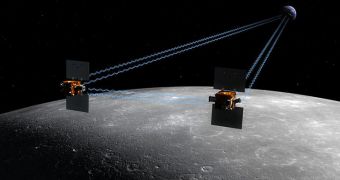Ebb and Flow, the two identical spacecraft making up the NASA Gravity Recovery and Interior Laboratory (GRAIL) mission, have just completed their prime mission studying the Moon, on May 29.
The vehicles began their assessment of the object's surface and interior on March 8, and conducted non-stop scientific investigations from their vantage point in orbit for 89 days. They will continue to do so once the extended phase of the mission begins, on August 30.
GRAIL will continue to receive funding until December 3, but it is possible that NASA will decide to support the mission beyond that time as well. These vehicles were designed to investigate Earth's natural satellite from crust to core.
The information is used to gain a deeper understanding of how the Moon's interior is set up, as well as on how the object itself formed, in the earliest days of the solar system. The amount of data GRAIL collected since this March is unprecedented for this type of studies.
Learning more about the Moon is very important because the data could then be used to figure out how Earth and the other rocky planets in the solar system evolved as well. The GRAIL spacecraft conducted their investigation from a polar orbit.
In all, they covered the entire lunar surface three times, using their onboard Lunar Gravity Ranging System instruments. These devices transmit radio signals between Ebb and Flow, constantly analyzing their positions in respect to each other.
Since areas featuring more mass exert a stronger gravitational pull, each spacecraft's speed is increased or decreased as it passes over a mountain or an area containing an underground plume of dense rocks. The LGRS helps measure these deviations.
Data collected in this manner are then used to create high-resolution maps of the lunar underground, revealing how matter is distributed under the surface, all the way to its core. The instruments were shut down yesterday, after the prime mission was completed.
“Many of the measurement objectives were achieved from analysis of only half the primary mission data, which speaks volumes about the skill and dedication of our science and engineering teams,” MIT expert and GRAIL principal investigator, Maria Zuber, explains.
“While there is a great deal of work yet to be done to achieve the mission's science, it's energizing to realize that what we traveled from Earth to the Moon for is right here in our hands,” she adds.
“GRAIL delivered to Earth over 99.99 percent of the data that could have been collected, which underscores the flawless performance of the spacecraft, instrument and the Deep Space Network,” Zuber concludes.

 14 DAY TRIAL //
14 DAY TRIAL //